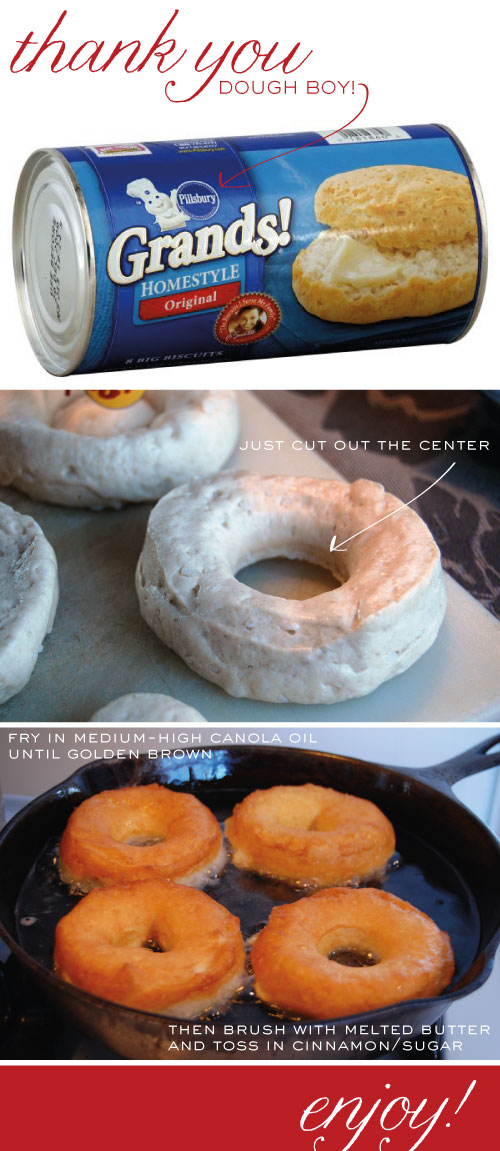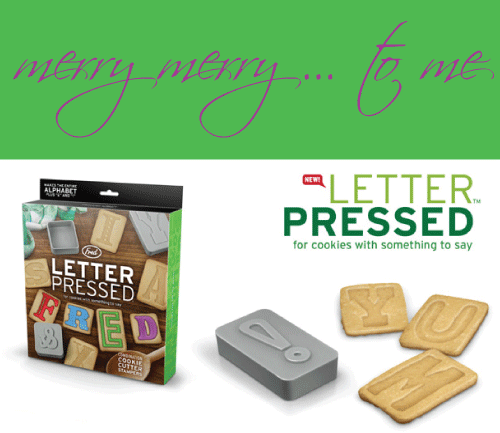 We were in Buffalo for the weekend and were delighted when our friend, Doug, made these for breakfast one morning. We thought he'd been up for hours fussing in my mom's kitchen... kneading and waiting and rolling... little did we know! He did spill the secret, which you're just not going to believe! I've made homemade doughnuts a few times and they're always delish, the problem is just that if you're serving them for breakfast, that means you're up hours before everyone else... Not anymore... Keep reading for the secret :)
We were in Buffalo for the weekend and were delighted when our friend, Doug, made these for breakfast one morning. We thought he'd been up for hours fussing in my mom's kitchen... kneading and waiting and rolling... little did we know! He did spill the secret, which you're just not going to believe! I've made homemade doughnuts a few times and they're always delish, the problem is just that if you're serving them for breakfast, that means you're up hours before everyone else... Not anymore... Keep reading for the secret :)

Homemade Croissants
We're embarking on a journey back to my favorite adventure from our winter break right after Christmas today for our Make-It Monday feature. I've always wanted to tackle homemade croissants from start to finish entirely by hand and I did just that. I'm going to warn you - it's quite a laborious task, but I think it was SO worth the efforts for the end prize (and my husband's family did too - though they didn't have to do the rolling!) Bon Appetit!


Recipe after the break...This recipe is from a 2000 issue of Gourmet Magazine...
Homemade Croissants
- 1 1/2 cups whole milk, heated to warm (105°F–110°F)
- 1/4 cup packed light brown sugar
- 1 tablespoon plus 1/4 teaspoon active dry yeast (from two 1/4-oz packages)
- 3 3/4 to 4 1/2 cups unbleached all-purpose flour
- 1 tablespoon kosher salt
- 3 sticks (1 1/2 cups) cold unsalted butter
Make dough: Stir together warm milk, brown sugar, and yeast in bowl of standing mixer and let stand until foamy, about 5 minutes. (If it doesn’t foam, discard and start over.) Add 3 3/4 cups flour and salt and mix with dough hook at low speed until dough is smooth and very soft, about 7 minutes.
Transfer dough to a work surface and knead by hand 2 minutes, adding more flour as necessary, a little at a time, to make a soft, slightly sticky dough. Form dough into a roughly 1 1/2-inch-thick rectangle and chill, wrapped in plastic wrap, until cold, about 1 hour.
Prepare and shape butter: After dough has chilled, arrange sticks of butter horizontally, their sides touching, on a work surface. Pound butter with a rolling pin to soften slightly (butter should be malleable but still cold). Scrape butter into a block and put on a kitchen towel, then cover with other towel. Pound and roll out on both sides until butter forms a uniform 8- by 5-inch rectangle. Chill, wrapped in towels, while rolling out dough.
Roll out dough: Unwrap dough and roll out on a lightly floured surface, dusting with flour as necessary and lifting and stretching dough (especially in corners), into a 16- by 10-inch rectangle. Arrange dough with a short side nearest you. Put butter in center of dough so that long sides of butter are parallel to short sides of dough. Fold as you would a letter: bottom third of dough over butter, then top third down over dough. Brush off excess flour with pastry brush.
Roll out dough: Turn dough so a short side is nearest you, then flatten dough slightly by pressing down horizontally with rolling pin across dough at regular intervals, making uniform impressions. Roll out dough into a 15- by 10-inch rectangle, rolling just to but not over ends.
Brush off any excess flour. Fold in thirds like a letter, as above, stretching corners to square off dough, forming a 10- by 5-inch rectangle. (You have completed the first "fold.") Chill, wrapped in plastic wrap, 1 hour.
Make remaining "folds": Make 3 more folds in same manner, chilling dough 1 hour after each fold, for a total of 4 folds. (If any butter oozes out while rolling, sprinkle with flour to prevent sticking.) Wrap dough tightly in plastic wrap and chill at least 8 hours but no more than 18 (after 18 hours, dough may not rise sufficiently when baked).
Roll out and cut dough: Cut dough in half and chill 1 half, wrapped in plastic wrap. Roll out other half on a lightly floured surface, dusting with flour as necessary and stretching corners to maintain shape, into a 16- by 12-inch rectangle. Brush off excess flour with pastry brush and trim edges with a pizza wheel or sharp knife.
Arrange dough with a short side nearest you. Cut in half horizontally and chill 1 half. Cut remaining half vertically into thirds, forming 3 rectangles. Cut each rectangle diagonally in half to make 2 triangles, for a total of 6 triangles.
Shape croissants: Holding short side (side opposite tip) of 1 triangle in one hand, stretch dough, tugging and sliding with other hand toward tip to elongate by about 50 percent.
Return to work surface with short side of triangle nearest you. Beginning with short side, roll up triangle toward tip. Croissant should overlap 3 times, with tip sticking out from underneath; you may need to stretch dough while rolling.)
Put croissant, tip side down, on a parchment-lined large baking sheet. (Curve ends inward to make a crescent shape if desired.)
Make more croissants with remaining 5 triangles, then with remaining rolled-out dough, arranging them 2 inches apart on baking sheet. Repeat rolling, cutting, and shaping procedures with chilled piece of dough.
Let croissants rise: Slide each baking sheet into a garbage bag, propping up top of bag with inverted glasses to keep it from touching croissants, and tuck open end under baking sheet.
Let croissants rise until slightly puffy and spongy to the touch, 2 to 2‚ hours.
Bake croissants: Adjust oven racks to upper and lower thirds of oven and preheat to 425°F.
Remove baking sheets from bags. Spritz inside oven generously with spray bottle and close door. Put croissants in oven, then spritz again before closing door. Reduce temperature to 400°F and bake 10 minutes without opening door.
Switch position of sheets in oven and rotate sheets 180°, then reduce temperature to 375°F and bake until croissants are deep golden, about 10 minutes more.
Cooks' note: •Baked and cooled croissants keep 1 month: First freeze them, uncovered, on baking sheets until firm, then wrap them snugly in foil before returning to freezer. When ready to serve, remove foil and bake (not thawed) on a baking sheet in a 325°F oven 5 to 10 minutes.
Mmmm ... cookies!
 The lovely ladies of Haute Papier are back, rested and gearing up for an oh-so exciting 2012! Though I'm sure everyone is starting to dig out of their pile of holiday treasures, I wanted to share one gift that I can't stop playing with! Check out these awesome Fred letterpress cookie cutters sure to please any lover of letterpress and baking. To say I'm enamored is the understatement of the season! Thanks, Sarah for this extra thoughtful gift!
The lovely ladies of Haute Papier are back, rested and gearing up for an oh-so exciting 2012! Though I'm sure everyone is starting to dig out of their pile of holiday treasures, I wanted to share one gift that I can't stop playing with! Check out these awesome Fred letterpress cookie cutters sure to please any lover of letterpress and baking. To say I'm enamored is the understatement of the season! Thanks, Sarah for this extra thoughtful gift!
Brown Butter Custard Pie with Cranberry Glaze
 I wrote about this recipe years ago when it first came out in Food & Wine Magazine and have made it every Thanksgiving since! It's the perfect non-traditional end to one of the most celebrated meals of the year and beautiful to boot! I love the look of the cranberry glaze on top of the speckled creamy filling and the little golden orange dollops of deliciousness by the way of sweet potato and white chocolate on top!
Brown Butter Custard Pie with Cranberry Glaze
2 teaspoons plain powdered gelatin
Reserved browned butter solids from Cinnamon Toast Crumb Crust (below)
1 cup whole milk
1/3 cup light brown sugar
1/4 teaspoon cinnamon
Kosher salt
3/4 cup plus 2 tablespoons heavy cream
1/4 cup sour cream
Cinnamon Toast Crumb Crust (recipe below)
3 1/2 ounces white chocolate, chopped
2 tablespoons unsalted butter
1/2 cup mashed sweet potatoes
1 cup cranberry sauce, pureed and strained
I wrote about this recipe years ago when it first came out in Food & Wine Magazine and have made it every Thanksgiving since! It's the perfect non-traditional end to one of the most celebrated meals of the year and beautiful to boot! I love the look of the cranberry glaze on top of the speckled creamy filling and the little golden orange dollops of deliciousness by the way of sweet potato and white chocolate on top!
Brown Butter Custard Pie with Cranberry Glaze
2 teaspoons plain powdered gelatin
Reserved browned butter solids from Cinnamon Toast Crumb Crust (below)
1 cup whole milk
1/3 cup light brown sugar
1/4 teaspoon cinnamon
Kosher salt
3/4 cup plus 2 tablespoons heavy cream
1/4 cup sour cream
Cinnamon Toast Crumb Crust (recipe below)
3 1/2 ounces white chocolate, chopped
2 tablespoons unsalted butter
1/2 cup mashed sweet potatoes
1 cup cranberry sauce, pureed and strained
Cinnamon Toast Crumb Crust 2 sticks unsalted butter 1/2 cup sugar 1 1/2 teaspoons kosher salt 1/2 teaspoon cinnamon 4 cups diced crusts and end pieces from 1 loaf of packaged white bread (10 ounces crusts)
 Instructions for the crust:
Instructions for the crust:
- Preheat the oven to 325°. In a saucepan, melt the butter. Cook over moderate heat, stirring, until the butter is golden brown, about 8 minutes; strain into a glass measuring cup. Reserve the browned butter solids for the Brown Butter Custard Pie.
- Pour half of the melted butter into a bowl. Add the sugar, salt, cinnamon and bread, and toss. Spread the bread on a baking sheet and bake for 35 minutes, stirring once or twice, until golden. Let cool.
- Rewarm the remaining butter; pour into a food processor. Add the croutons and pulse to fine crumbs; spoon the crumbs into a 10-inch pie plate. Refrigerate for 5 minutes. Press the crumbs over the bottom and sides of the pie plate; refrigerate the crust until chilled, 15 minutes.
Instructions for the pie:
- In a microwave-safe bowl, sprinkle the gelatin over 2 tablespoons of water and let stand until softened, 3 minutes. Microwave at high power for 10 seconds, until melted. In a microwave-safe measuring cup, microwave the reserved brown butter solids with the milk, sugar, 1/8 teaspoon of the cinnamon and a pinch of salt until warm. Whisk in the gelatin and refrigerate until set.
- In a bowl, whisk 3/4 cup of the heavy cream and sour cream to soft peaks. Whisk the custard to loosen it, then fold into the whipped cream. Pour the custard into the Cinnamon Toast Crumb Crust; refrigerate for 30 minutes.
- In a microwave-safe bowl, melt the white chocolate and butter. Add the mashed sweet potatoes, the remaining 2 tablespoons of heavy cream and 1/8 teaspoon of cinnamon and a pinch of salt; whisk until smooth. Transfer the sweet potato ganache to a pastry bag fitted with a 1/2-inch plain tip and refrigerate until chilled slightly, 15 minutes. Pipe 1-inch mounds around the edge of the pie. Refrigerate until the ganache is set, 10 minutes.
- Pour the cranberry puree over the pie and spread it evenly with the back of a spoon. Refrigerate until set, at least 30 minutes. Cut the pie into wedges and serve.
Elegantly Eggplant

